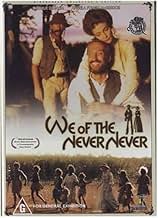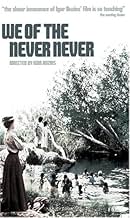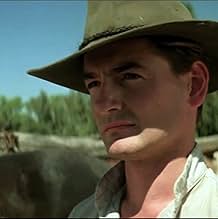Jeannie Gunn faced being the only civilised woman in an uncivilised land. A story of personal triumph about one woman who reached out in a hard, hostile, prejudiced world and managed to find... Read allJeannie Gunn faced being the only civilised woman in an uncivilised land. A story of personal triumph about one woman who reached out in a hard, hostile, prejudiced world and managed to find love.Jeannie Gunn faced being the only civilised woman in an uncivilised land. A story of personal triumph about one woman who reached out in a hard, hostile, prejudiced world and managed to find love.
- Director
- Writers
- Stars
- Awards
- 1 win & 5 nominations total
- Director
- Writers
- All cast & crew
- Production, box office & more at IMDbPro
Featured reviews
The Never Never is Australia's home-grown version of a hostile environment. Bad enough now with modern conveniences but brutal in the early 1900s. Survival depended on factors few today could fathom. This movie is an open window to that time. It's about relationships that had to be built from the sweat and dust of hard work. Hollywood doesn't have its mark on this one so see it for certain. The right drama with the right characters. Professional acting producing a beautiful memory.
"We of the Never Never" is a rare film. A near-epic made by and starring people from Australia. I can't really say whether no Hollywood people were involved, but it doesn't seem so.
Most Americans will have a some trouble understanding dialogue here and there. I have spent time in Oz and N.Z. and I didn't catch some of it. Just another reason why it's a true Australian production.
And it's quite upfront for 1982. The interaction/friction between Aboriginals and Whites is not most of the film, but a large part of it.
But to see it is to see something uniquely Australian, IMHO. Got to read the book!
Most Americans will have a some trouble understanding dialogue here and there. I have spent time in Oz and N.Z. and I didn't catch some of it. Just another reason why it's a true Australian production.
And it's quite upfront for 1982. The interaction/friction between Aboriginals and Whites is not most of the film, but a large part of it.
But to see it is to see something uniquely Australian, IMHO. Got to read the book!
Watching the film straight after reading the book made for a very poor viewing experience. Where the characters in the book were alive and so multi-dimensional, they sadly lost most of that in the film, which chose to diverge from the book in so many places that it became unrecognizable. Key events in the film did not happen in the book and others that I considered important were omitted from the film. The book was set as a narrative, you were following her thoughts, listening to her voice and I wish they had transferred this concept to the film. Too many key characters were omitted from the movie and those that remained seemed to have lost their voices by being given too few lines. All in all a nice movie, and beautifully shot and acted, but not a true representation of the book or the true events.
8BOUF
Despite its rather rambling structure, this is movie is a great achievement - as a portrait of a 19th century, white Australian woman trying to cope with life in the outback. It's beautifully photographed, written and acted, with the exception of the male lead, who is astoundingly miscast. Such a shame, as otherwise this would have been a completely absorbing and accurate depiction of conditions faced by a woman, married to a typical man of the land; the only white woman in a very male world, and inn a world in which indigenous people are treated as third class citizens. I recommend this to schools and educators and to film historians - as an example of how to make a great movie with not much money and a lot of commitment. See the extras on the DVD - even in those, the male lead reveals himself to be completely out of step with the spirit of the film.
I found this a very beautiful film, with charismatic leads and a very realistic portrayal of outback hatdships, the predicament of the aborigines, and the fleetingness of life amidst death. It looks great and has a good romantic score. I felt for this couple, shared their hopes and their losses. My only gripe is that I may have watched a cut version, as there seemed to be a few jumps in time, and not enough of the interesting background characters
Did you know
- TriviaThe remains of Mrs. Aeneas Gunn, and several other characters featured in the book and movie, are buried at the Elsey Cemetery. Jeannie Gunn is buried in Melbourne, but there is a memorial next to her husband's grave, which reads: ''IN loving memory of the 'Little Missus' JEANNIE GUNN Born. June 5th 1870. Died. June 9th 1961.''
- GoofsThe city of Darwin is mentioned several times, but Palmerston was not renamed Darwin until 1911. This was the official change but it was common to refer to it as Port Darwin or Darwin long before this.
- ConnectionsFeatured in We of the Never Never: Behind the Scenes Gallery (2004)
Details
- Release date
- Country of origin
- Official site
- Languages
- Also known as
- Land hinter dem Horizont
- Filming locations
- Katherine, Northern Territory, Australia(environs)
- Production companies
- See more company credits at IMDbPro
Box office
- Budget
- A$3,200,000 (estimated)
- Gross worldwide
- $13
Contribute to this page
Suggest an edit or add missing content

Top Gap
By what name was We of the Never Never (1982) officially released in Canada in English?
Answer


























